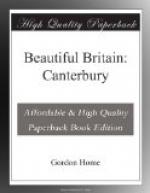The north-west transept, on the left as the steps to the choir are ascended, is the scene of Becket’s martyrdom, and the vergers show the traditional spot where he fell. From the opposite transept, steps lead down to the undercroft, and also up to the south choir aisle—the way the pilgrims approached the shrine of St. Thomas. Also opening from the south-west transept is St. Michael’s or the Warrior’s Chapel, as it is now popularly called. In the illustration facing p. 30, the tomb of Lady Margaret Holland and her two husbands, John Beaufort, Earl of Somerset, and Thomas, Duke of Clarence, is shown occupying the centre of the chapel, but it just misses a more interesting, if much less beautiful, tomb, that of Stephen Langton, the courageous Archbishop who took such a leading part in forcing John to sign Magna Charta. The plain sarcophagus is partly within and partly outside the chapel, for when it was rebuilt in the fourteenth century it was extended so much to the east that it became necessary either to move Langton’s tomb or else to make an arch in the wall, and the latter course was taken, with the curious result still to be seen. An astonishing contrast to the clear-sighted action of this Norman Archbishop was the attitude of Archbishop Howley (1828-1848) whose bitter hostility to the Reform Bill in 1831 so raised the anger of the people of Canterbury that they greeted his next arrival in the city with showers of stones and rotten eggs. In the midst of a howling mob the archiepiscopal carriage slowly struggled to the Deanery, bearing in it the amiable Churchman who was convinced that the Reform Bill was “mischievous in its tendency, and extremely dangerous to the fabric of the constitution.” Such words are deeply interesting at the present day, when many people think they see, in progress on the same lines, dangers of an equally unfounded order.
Passing along the south aisle of the choir, one gradually sees the whole of the elaborately devised eastern parts of the Cathedral as they were reconstructed by William of Sens and his English successor. The arcades of alternately circular and octagonal pillars have richly carved foliated capitals, and there is a lightness in form and a profusion of carving that tells of the coming of the Gothic style—indeed, so far in advance of the plain Norman work of Conrad




